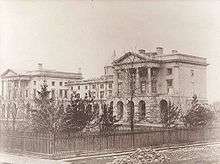Osgoode Hall
| Osgoode Hall | |
|---|---|
 | |
| General information | |
| Type | office and courts |
| Location | 130 Queen Street West, Toronto, Ontario, Canada |
| Coordinates | 43°39′08″N 79°23′08″W / 43.65222°N 79.38556°WCoordinates: 43°39′08″N 79°23′08″W / 43.65222°N 79.38556°W |
| Construction started | 1829 |
| Technical details | |
| Floor count | 3 |
| Design and construction | |
| Architect | John Ewart and William Warren Baldwin |
| Designated | 1979 |

Osgoode Hall is a landmark building in downtown Toronto dating from 1829. It originally served to house the regulatory body for lawyers in Ontario along with its law school (formally established as Osgoode Hall Law School in 1889) which was the only recognized professional law school for the province at the time.[1] It was constructed between 1829 and 1832 in the late Georgian Palladian and Neoclassical styles. It currently houses the Ontario Court of Appeal, the Divisional Court of the Superior Court of Justice, the offices of The Law Society of Upper Canada and the Great Law Library. The portico of Osgoode Hall's east wing was built at the head of Toronto's York Street to serve as a terminating vista, though it is now obscured by trees planted on the building's lawn.
Osgoode Hall was named in honour of the province's first chief justice, William Osgoode [2] from which Osgoode Hall Law School also get's its name. It was designated a National Historic Site of Canada in 1979.[3][4] It was also designated by the City of Toronto under the Ontario Heritage Act in 1990.[5]
History
The six-acre (24,000 m²) site at the corner of Lot Street (Queen Street West today) and College Avenue (University Avenue today) was acquired by the Law Society in 1828.[6] At the time, the location was on the northwest edge of the city, which has since grown around the building. It was originally bounded on its north side by Osgoode Street, and on its east side by a street that would eventually be known as Chestnut Street. The former no longer exists, and the latter now stops at Armoury Street as Nathan Phillips Square now lies to the east. The original 2 1⁄2-storey building was started in 1829 and finished in 1832 from a design by John Ewart and W. W. Baldwin. The structure was named after William Osgoode,[7] the first Chief Justice of Upper Canada (what is now the Canadian province of Ontario).
Between 1838 and 1843, the hall was turned into troop barracks.[6] When the Law Society regained possession in 1844, an expansion was designed by Henry Bowyer Lane; the West Wing and Library were built, with two domes (later removed) over the library to connect the two wings.[6] In 1846 the Law Society entered into an agreement with the government to house the province's Superior Court at the hall. Today, the building is jointly owned by the Law Society and the Government of Ontario.
From 1855 to 1857 the building was refurbished and enlarged again, according to a design by the firm Cumberland and Storm, to accommodate courts with the original 1829 building becoming the east wing. From 1880 to 1891 the building was again expanded twice in order to accommodate its law school.
Despite the expansions, the hall presents a unified design in the late Palladian style. The iron fence surrounding the lawns of Osgoode Hall has become a landmark in itself. Its distinctive iron gates are narrow and restrictive; it is a long-standing myth that they were designed to keep livestock out of the grounds of the hall and in the 1950s, students did attempt to pass a cow through one of the gates (they failed). The gates were likely due to Victorian architectural fashion, rather than wandering cattle.[8][9][10]
Two libraries are housed within Osgoode Hall: the Great Library of the Law Society of Upper Canada and a smaller library for judges. The Great Library was designed by Cumberland and Storm (1857–1860) and features an ornate plaster ceiling, cork floors, and etched glass windows. A War Memorial by Frances Norma Loring (1887–1968), sculpted in 1928, was added to the Library in honor of Ontario lawyers and law students killed during the First World War. Behind the Great Library (and accessible through it) is the American Room, designed by Burke and Horwood in 1895, a more intimate room with a spiral staircase. The Toronto Courthouse at 361 University Avenue directly to the north is accessible through a connecting tunnel.
Notes
- ↑ http://www.osgoode.yorku.ca/about/history/
- ↑ http://www.heritagefdn.on.ca/userfiles/HTML/nts_1_6190_1.html Ontario Heritage Trust Osgoode Hall
- ↑ Osgoode Hall. Directory of Federal Heritage Designations. Parks Canada. Retrieved 22 August 2012.
- ↑ Osgoode Hall. Canadian Register of Historic Places. Retrieved 22 August 2012.
- ↑ 130 Queen Street West, Toronto Inventory of Heritage Properties
- 1 2 3 William Renwick Ridell, "Osgoode Hall", Report of the Annual Meeting, Canadian Historical Association, Vol. 1, No. 1, 1922.
- ↑ "Courageous settlers first located in Carleton back in 1818". Ottawa Citizen. Apr 28, 1953. pp. A20. Retrieved 2 December 2015.
- ↑ The Execution. Osgoode Hall Turns 175 - Documenting a Landmark. Archives of Ontario. Retrieved 2008-03-06.
- ↑ Osgoode Hall. Lost Rivers. Retrieved 2008-03-06.
- ↑ Law, Susan. "Osgoode Hall Fence". Osgoode Hall (website). (Accessed 21 June 2007).
See also
| Wikimedia Commons has media related to Osgoode Hall. |
External links
- Osgoode Hall Turns 175 - Documenting a Landmark Web exhibit at the Archives of Ontario
- Susan Law's personal Osgoode Hall main site
- Audio Tours of Osgoode Hall from the Law Society of Upper Canada website.
- Visual Tour of Osgoode Hall from the Law Society of Upper Canada website.
- Osgoode Hall National Historic Site of Canada. Canadian Register of Historic Places.
- Information on Osgoode Hall tours and other heritage programs on the Discover Ontario Museums website.
